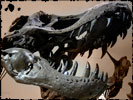National Geographic Channel
Dinosaurs
A Night of Dinosaur Discoveries
Dino Death Trap–Sunday, Dec. 9 at 8P et / 9P pt
Dino Autopsy–Sunday, Dec. 9 at 9P et / 10P pt
Dissecting a Dinosaur Mummy

The dino-mummy fossil undergoes intense computer-aided tomography scanning at Boeing.
But the iron carbonate sarcophagus encasing Dakota is an even more daunting obstacle than its sheer size, Anders explains. The rock is far denser than anything that the scanner was designed to penetrate. Andres has found himself cranking up the intensity of the scanner’s x-ray bombardment higher and higher. “Essentially, it’s a giant version of the machine you would have in a cancer center–but instead of exposing the patient for a few seconds, we’re running it around the clock for as long as we can. The longest, I think, has been seven days straight.”
Andres has made tooling improvements in the process that he hopes will soon result in a breakthrough on the main part of Dakota’s body. But the scanning already has yielded several terabytes of data for the animal’s tail, which is easier to penetrate. The level of detail–enough to image individual grains of sand and rock inside the mummy–enables researchers to see the subtle textures of Dakota’s skin, almost down to the level of pores.
Based on the dimensions of Dakota’s skin capsule, paleontologists have calculated that the duckbill’s posterior was 25 percent more massive than expected. Manning puts it a bit crudely: “This animal had a big ass.”
“Obviously if you have a skinny dinosaur, it’s not going to walk as fast or run as fast as a really musculy dinosaur”
That’s a significant detail, because up to this point, paleontologists have been forced to use the size of scars on dinosaur bones to roughly estimate muscle size. Being able to measure Dakota’s skin capsule, in contrast, for the first time gives scientists a much more accurate picture of the creature’s musculature–information that they can use to simulate how it moved.
“Obviously if you have a skinny dinosaur, it’s not going to walk as fast or run as fast as a really musculy dinosaur,” explains Bill Sellers, a University of Manchester locomotion biologist. His computer simulation reveals that Dakota may have been able to reach 25 miles per hour at full tilt. “Not quite as fast as a galloping horse,” Sellers explains. “But it’s really a pretty incredible speed for something as large as our Hadrosaur.” That might significantly alter our understanding of duckbills, transforming them from helpless prey to creatures capable of outrunning a larger predator.
Lyson notes that Dakota includes a much better-preserved hand than the mummified appendage in a German museum that up to this point has been the best specimen. Dakota’s hand confirms that two of a duckbill’s four digits were encased together in skin, with a calloused end. “They probably used that for swimming,” he notes. “In addition to roaming on land, they were partly aquatic, well adapted for eating the vegetation on the bottom.”
“We’ve already significantly advanced the science,” Lyson says. And even more striking revelations are likely to come.
at Boeing use the largest CT-Scanner on the planet. But will this high-stakes, high-tech paleontology work?



